
Myra here.
It’s Monday, What are You Reading is a meme hosted by Jen from Teach Mentor Texts and Kellee and Ricki from Unleashing Readers (brainchild of Sheila at BookJourney). Since two of our friends, Linda from Teacher Dance and Tara from A Teaching Life have been joining this meme for quite awhile now, we thought of joining this warm and inviting community.
Last Week’s Review and Miscellany Posts
We are also inviting everyone to join our new Reading Challenge for 2014 called Check Off your Reading List Challenge (CORL 2014). Do click here to know more details and to sign up!
In a few days, we will be welcoming the New Year. What better way to do that than to feature myths, gods and goddesses, perfect for our theme.
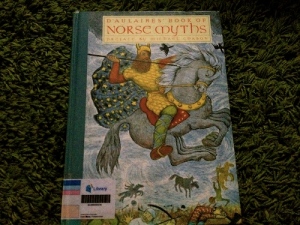 D’Aulaires’ Book of Norse Myths
D’Aulaires’ Book of Norse Myths
Text and Illustrations by: Ingri and Edgar Parin D’Aulaire Preface by: Michael Chabon
Published by: The New York Review Children’s Collection, 1997; original copyright 1967
Borrowed from the library. Book photos taken by me.
I have read a few stories from myths when I was younger and have always been fascinated by them. I know the flight of Icarus, Pandora’s Box, King Midas’ touch, Echo and Narcissus – mostly the short stories that have been collected in the second volume of the Childcraft Encyclopedia: Stories and Fables. Nothing prepared me, however, for this gorgeous book written and illustrated by the D’Aulaires. This must be one of the best books on myths out there.

I started with Norse Myths because I knew little about it. I especially loved this full page spread on the nine Norse Worlds. Since my family and I have been watching the Thor films, it excited me to no end that there are so many worlds out there that have not been shown as yet in the movies.
I loved knowing about Ymir, the first of the race of the jotuns, and how he was nourished by the sacred hornless ice cow. Especially how a male and female jotun came to life from Ymir’s left armpit and a troll with six heads from his feet.
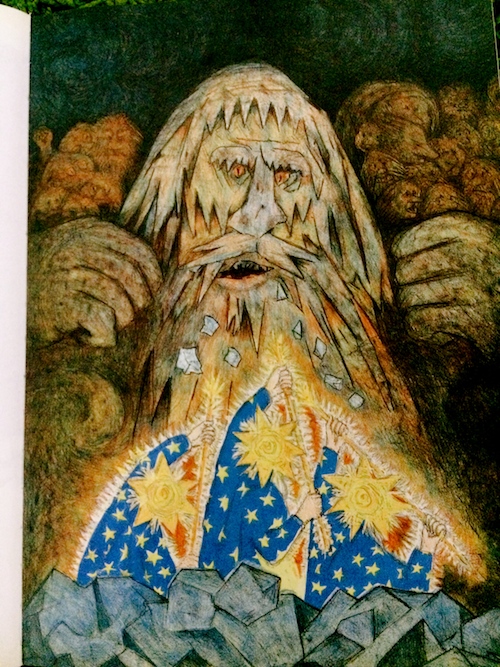
The three Aesir gods could trace their lineage from this sacred cow and a lovely jotun maiden (quite rare for their species): Odin, Hoenir and Lodur who eventually needed to get rid of Ymir, their creator, for them to rule the nine worlds. If one would really stop and think about it, these myths, not unlike the fairy tales, are action-packed, even quite violent (without necessarily being gory), and simply broke all the rules in terms of what society perceives to be appropriate behaviour. There is just absolute freedom in how the gods governed themselves, despite the existence of seemingly-arbitrary rules that the gods could bend and twist to serve their own nefarious or good-intentioned purposes.
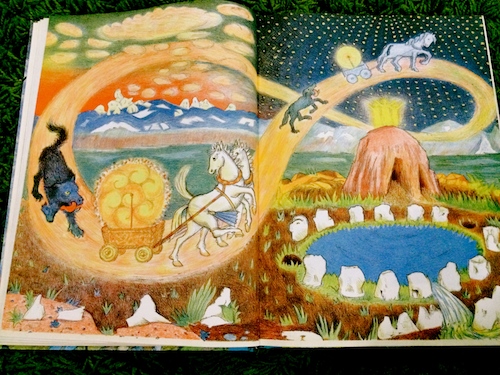
I also found out from the book that Loki’s blood brother was Odin, not Thor. Odin was the real kick-ass god here – truly deserving of being the best among all the Aesir gods for all that he has done to become the Wisest of the Wise, even giving his left eye to drink from the well of Wisdom. Thor, the Thunder God, struck me as being impulsive, rash, loud, and a drunken brute who is unable to control his temper.

Loki, on the other hand, apart from being a shape-shifter, is cunning, sly, mischievous, charmingly-contrite whenever he is busted by the other gods, and provided opportunities for the other gods to display their heroism or their stupidity whichever the case may be – it usually goes both ways.
I also loved knowing about Balder, the God of Light – said to be the kindest and gentlest of all the gods and also the most beautiful. He was also portrayed to be loyal to his wife Nanna.
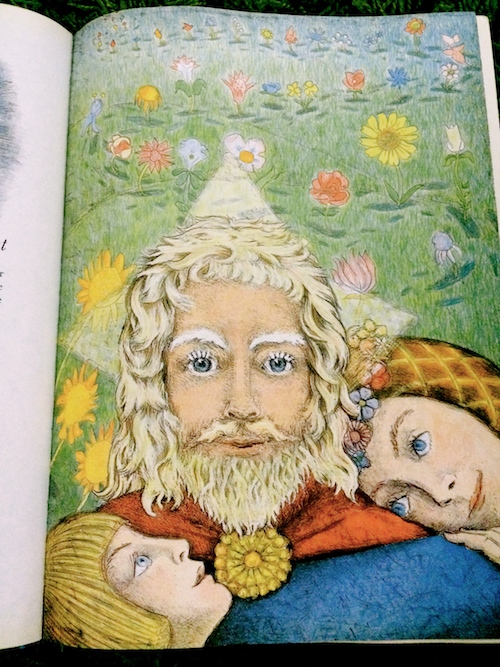
I was particularly taken by Bragi, God of poetry. Interestingly, it was a magical mead (created from the essence of Kvasir, the spirit of knowledge, berries, spit of the gods, honey and sprinkling of magic herbs) that caused such stately verse in whoever drinks it. Bragi had Idunn, the keeper of the apples of youth for his wife.

If, for some reason, these mortal gods are unable to eat from Idunn’s apples, they would look this way:

I especially loved the artwork of the D’Aulaires. The book’s afterword describes how the couple met at art school in 1921 in Munich. After moving from Norway, to Paris, they eventually sailed to New York where their career was launched. Their artwork is quite distinctive and quite difficult to do. According to the book:
Originally, they used stone lithography for their illustrations. A single four-color illustration required four slabs of Bavarian limestone that weighed up to two hundred pounds apiece. The technique gave their illustrations an uncanny hand-drawn vibrancy.
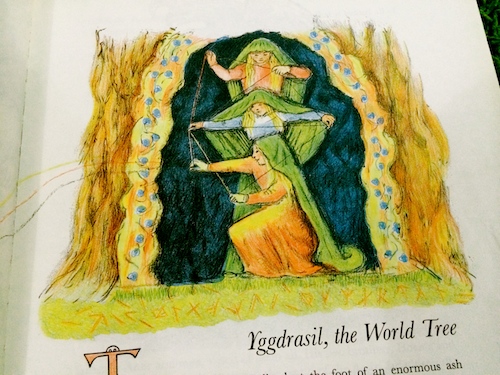
When, in the early 1960s, this process became too expensive, the d’Aulaires switched to acetate sheets which closely approximated the texture of lithographic stone.
I couldn’t imagine the painstaking care the couple must have done alongside the publishers to create a timeless piece of art such as the one I am holding in my hands.
D’Aulaires’ Book of Greek Myths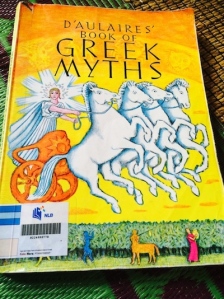
Text and Illustrations by: Ingri and Edgar Parin D’Aulaire
Published by: Delacorte Press, 1962
Borrowed from the library. Book photos taken by me.
In contrast to Norse myths, there are more deities in this book as it also features nymphs, satyrs, centaurs, minor gods, and the mortal descendants of Zeus. As I read through the names of the gods, I am reminded of their Roman counterparts. A summary of this could also be found somewhere at the back of the book, complete with illustrations of each god (e.g. Poseidon – Neptune; Hermes – Mercury; Athena – Minerva among others).
What I loved about these two books is that murder and mayhem, the gods’ cruelties and benevolence are portrayed as matter-of-fact and told in such a riveting narrative that is the trademark of the D’Aulaires.
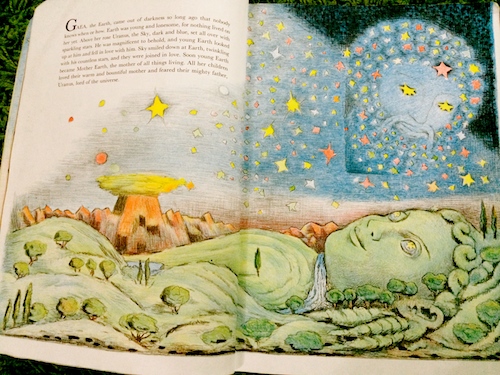
What struck me in this collection of stories is how all-powerful Gaea, Mother Earth seemed to be. She is generous as she is sadistic, as nurturing as she is punitive. Even Zeus, believed to be the all-powerful god, and borne against the wishes of his father Cronus, lord of the universe, is continually hypervigilant about the wiles and guiles of Gaea.
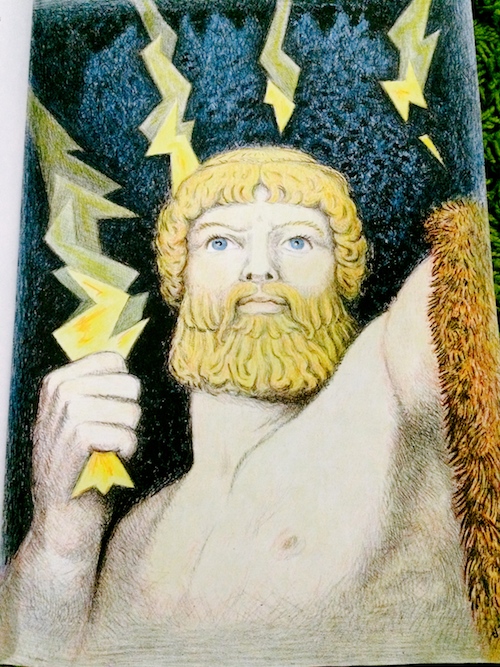
There is matricide, patricide, incestuous relations, and eating one’s offspring happening among the gods. Yet, what I found infinitely curious is how the same acts are punished if done by mortals. Even the gods’ own mortal children are not spared if they commit kinslaying or some other such barbaric acts. It appears that this is only a privilege of the gods.

One of my absolute favorite goddesses of all time is Athena, the goddess of wisdom, also described to the favorite child of Zeus. How can Athena not be smart when “she had sprung fully grown out of her father’s head.” (p. 34). Myths are such great stuff.
Pandora’s box was one of my favourite stories as a young child. I loved how the evils of the earth have been portrayed by the D’Aulaires:
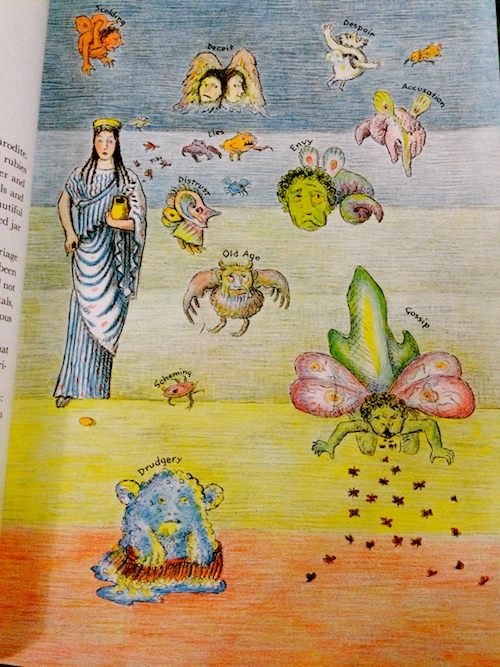
I also enjoyed reading about tragic love stories that end in unhappiness and compromise such as the story of Hades and Persephone:
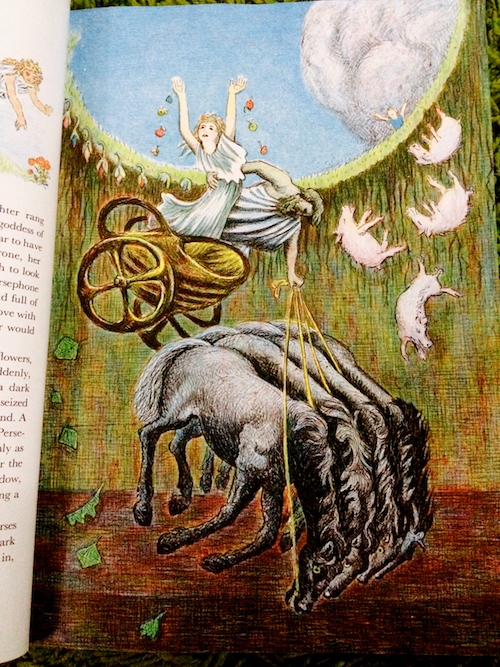
or end in death such as the love story of Orpheus and Euridice
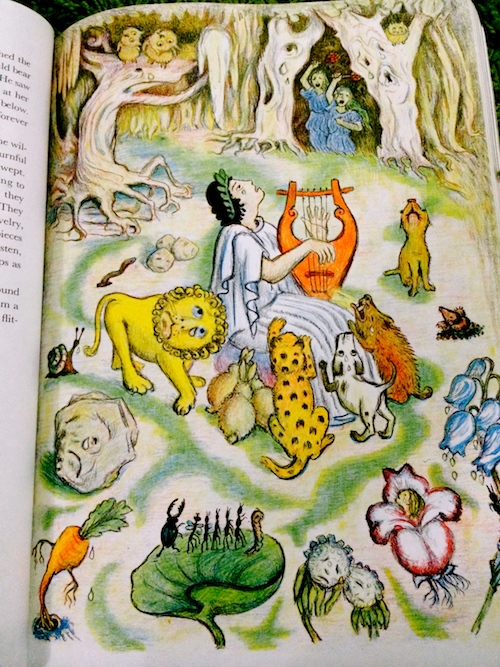
and in bitterness such as the lovestory between Jason of the Argonauts of the Golden Fleece fame and Medea the Enchantress (also known as a witch).
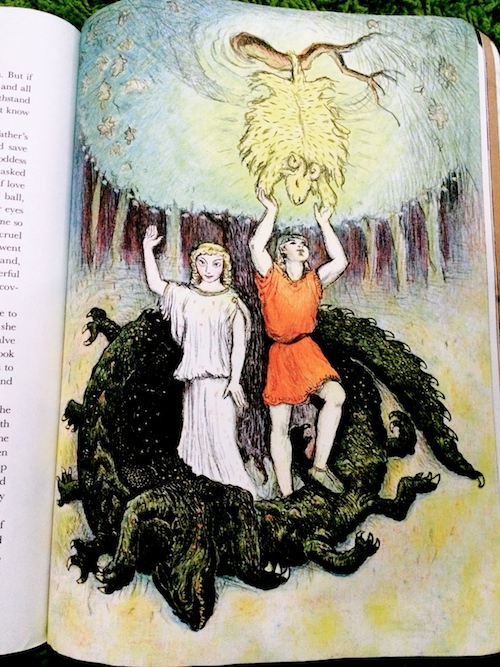
There is just so much to love with these stories. Admittedly, it requires keen attention just to make sure that one is not lost with all the names and how each one is connected to each other. There are stories within stories within stories. The D’Aulaires’ breathtaking artwork elevate these tales to a different dimension altogether. I hope to own these two books in the future. They are definitely collectors’ items.
Currently Reading…
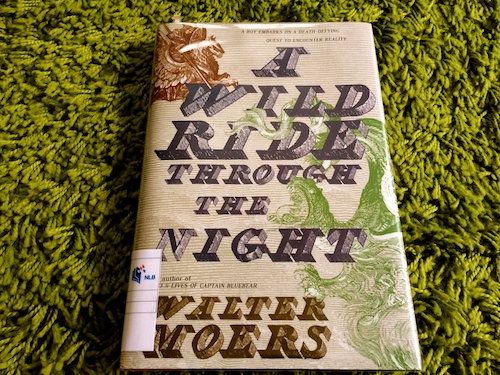
Done reading Moers’ A Wild Ride through the Night. While not my absolute favourite Walter Moers novel, I still enjoyed it greatly. I shall review this for our next theme. Very excited to share this ingenious book.

I’m also starting to read Jennifer A. Nielsen’s The False Prince in connection to our next bimonthly theme in January-February. So far, so good. Riveting first chapter, I think.

Read-a-Latte Challenge Update: 258, 259 (150)

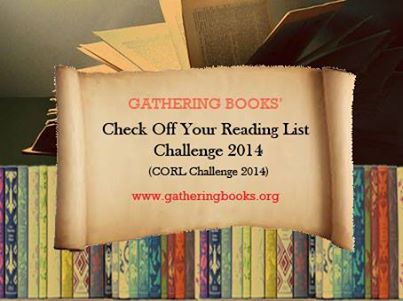









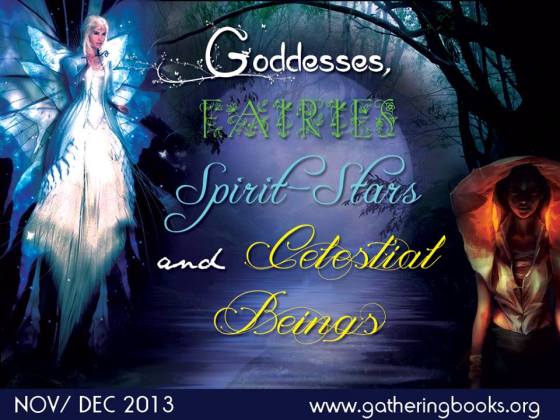
The Tolkien book looks amazing. Your posts are always so informative and colorful!
LikeLike
I should look for newer editions of those D’Aulaire books for my media center. Ours are quite shabby and without the vibrant illustrations you show. I read The False Prince but thought it was a pale shadow of The Thief by Megan Whalen Turner. Come see my Monday Report here. Happy reading and happy new year!
LikeLike
I was so into myths when I was younger. Those books look beautiful. Happy New Year!
LikeLike
I am not familiar with these D’Aulaire books but they look wonderful – great illustrations! Letters From Father Christmas – a wonderful book! I LOVED the False Prince when it first came out – so did my son. We have 3 copies of it in our school library and it’s ALWAYS out! Would love to know how you enjoy the rest of it! Happy reading and blogging in 2014, Myra! Thanks for all your great posts!
LikeLike
I’ve had so many students choose myths for their unit studies, and the D’Aulaire books are terrific for that. I don’t know as much about the Norse myths either, love your sharing about the god of poetry, Bragi. I hope you enjoy The False Prince-great reading there I thought, Myra. Thanks for all you do and share!
LikeLike
The Norse myth book is available at my library! Thank you for introducing me to their work.
LikeLike
I just gave my nine-year-old nephew the D’Aulaire’s Greek Myths book for Christmas! I love that one and hope he enjoys it too!
LikeLike
I think I read False Prince in one sitting! I love a book that sucks you in and won’t let you go til you’ve finished. Hope you enjoy it.
LikeLike
Those are some interesting mythology books! I have D’Aulaires’ Book of Greek Myths in my bookshelf from years ago, although i can’t recall how much I read of it. We were doing a unit on mythology and it terrified me to death! Now I find it interesting, but it can still be pretty scary for me sometimes.
I remember how during the unit people were always like, “You must’ve come across mythology in your reading,” and I was like, “I don’t think so.” I’ve been more compelled to read some of it when I read The Raven in English class earlier this year. I’ve already read it a few times so I thought I knew everything, but some of the people in the class were very knowledgeable about mythology and shed new light on it. I guess I’ll have some catching up to do 🙂
Happy New Year!
LikeLike
I love mythology and what a beautiful resource D’Aulaires is! Will definitely need to get it.
Happy new year and happy reading!
LikeLike
I love the sounds of the Norse and Greek ones. I love the Norse mythology, and the Greeks are just… interesting. 😉
LikeLike
So excited you are going to read the False Prince! Love this series!
LikeLike
Pingback: Young Zeus to Usher in the New Year |
As always, you’ve got quite the unique collection of titles! I need to be exposing my students to more Greek mythology, and find that it is hard to find readability and appropriateness for 9 year olds. The False Prince will not let you down! I love the main character…he is quite amusing!
LikeLike
Pingback: More Books on Myths, Gods, and Heroes |
Pingback: [BHE 94] More Love for Royalty |
Pingback: A Universe of Fierce and Hairy Creatures in D’Aulaires’ Book of Trolls | Gathering Books
Pingback: Embracing One’s Vulnerability and Renouncing One’s Divinity in A Female-Centric Retelling of a Greek Myth – Gathering Books